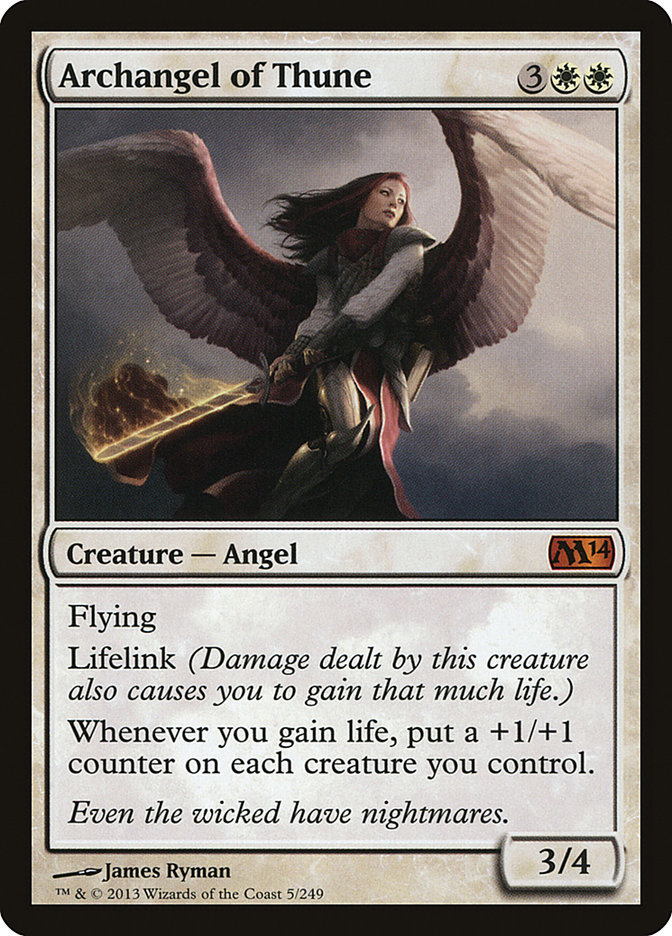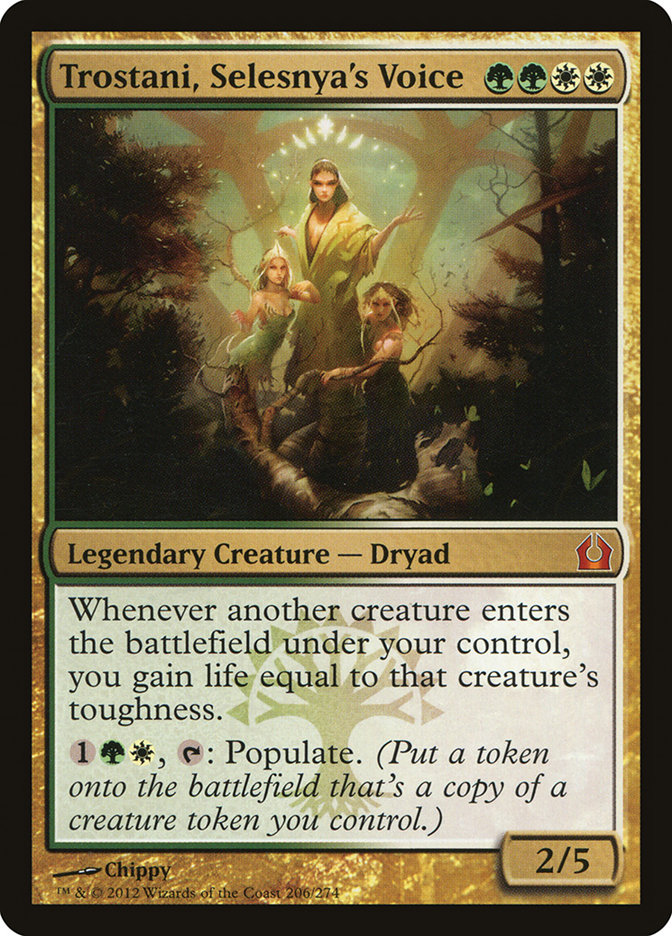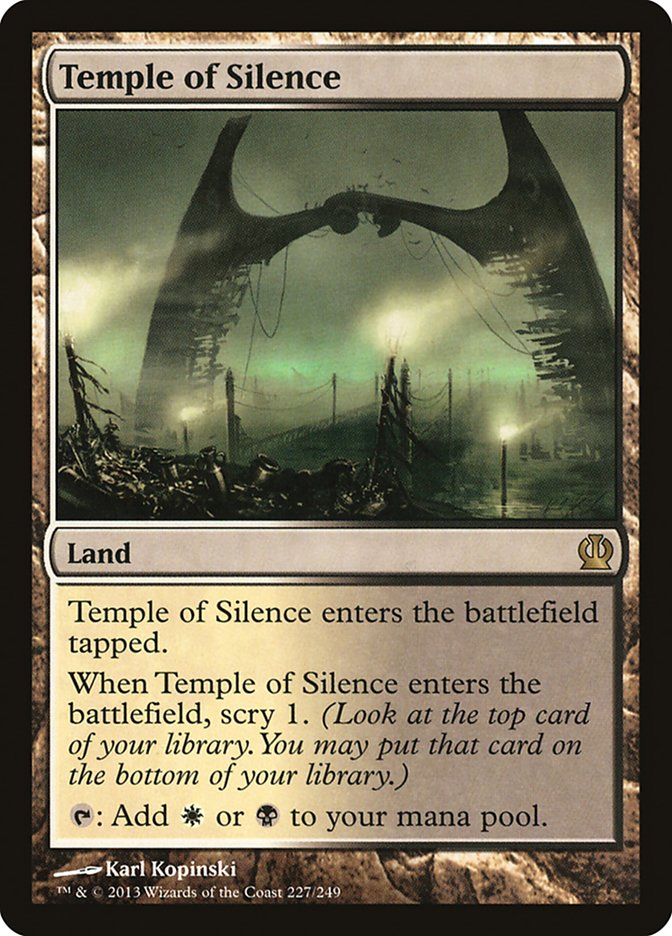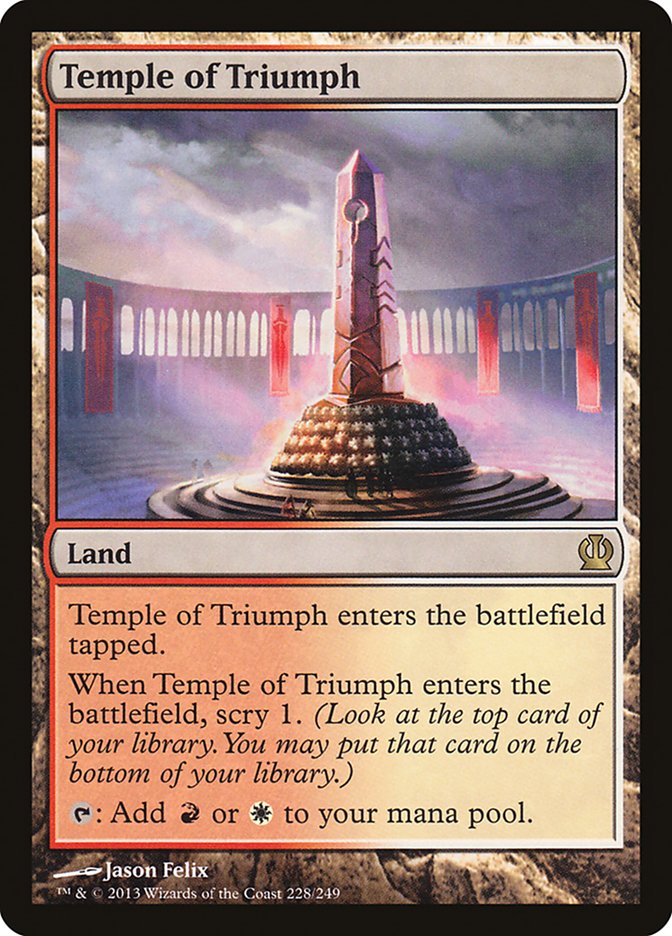The second week of Theros-thrusted Standard buried its veritable bident in my hometown of Cleveland, Ohio last weekend. The metagame snapped violently back from the first week’s showcase of various U/W variants and a Mono-Red victory to a paint a completely different picture this time around, showcasing elimination rounds composed of more than 50% green aggro variants balanced by removal-based board control decks with nary a Sphinx’s Revelation to be seen in Top 8.
To wit:
| G/W Aggro | * | 1 |
| B/W Midrange | 1 | |
| Big Dega | 1 | |
| Junk Midrange | 1 | |
| Mono-Green Aggro | 1 | |
| Mono-Red Aggro | 1 | |
| Naya Aggro | 1 |
So what does this mean for players preparing for this weekend’s Milwaukee Standard Open, the dozens of impending State Championships, or, you know, Pro Tour Dublin… all of which are Standard-starring events?
Which Version of G/W Aggro is Best (or at least which one should we test against)?
Two versions of G/W Aggro made Top 8 of the Cleveland Open. Like last week’s Mono-Red first-and-eighth split, we have two ostensibly similar decks at the opposite ends of the elimination rounds that are actually quite distinct from one another.
Creatures (24)
Planeswalkers (2)
Lands (7)
Spells (27)

Gerhart’s Cedric Phillips Experience is essentially a study in the best green and white drops plus methods of getting them through.
Ajani, Caller of the Pride has historically gotten some criticism for being a planeswalker that can’t defend himself, but in this G/W deck there are so many creature permanents to throw in front of Ajani (most of them being bigger than what the opponent might muster to attack with) that Ajani will generally be safe long enough.
Ajani doesn’t have to stick around very long in this deck. How many hits does it take for a flying, potentially Selesnya Charm’d, double striking Wurm token to win the game?
Gods Willing is probably my favorite card in Theros, and its positioning here is pretty perfect. Gods Willing is basically always going to trade up; it’s one mana and can act like either a Negate or a Falter. In a deck like this one, that has such powerful cards and a desire to keep pressure on, the Scry 1 can be backbreaking for the opponent.
Notable for this version is the semi-transformation out of the sideboard. The Ceddy P Experience has Archangel of Thune and Trostani, Selesnya’s Voice in the sideboard, which work well separately, can create a potential lockdown situation for opposing aggro decks, but actually link up as a kind of combo.


You start with the four drop Trostani, Selesnya’s Voice. You play Archangel of Thune; the latter enters the battlefield and Trostani ups your life; but when that happens, Archangel of Thune has a trigger of its own. If you already have some creatures in play, all the better; but just the two can set up a tremendous advantage on the board.
Creatures (20)
- 3 Dryad Militant
- 1 Trostani, Selesnya's Voice
- 4 Experiment One
- 4 Voice of Resurgence
- 4 Fleecemane Lion
- 4 Boon Satyr
Lands (6)
Spells (34)

The previous G/W deck played Rootborn Defenses as a four-of in the sideboard for sweep spells and Unflinching Courage in the sideboard to go over the top of aggro opponents. But Open winner Finnegan played both main deck!
As with Gerhart’s list, Finnegan’s is a study in awesome creatures; Voice of Resurgence and Fleecemane Lion on the two… But maindeck Rootborn Defenses helps to justify Fleecemane Lion-minus Call of the Conclave.
This deck has a substantial tokens sub-theme between Advent of the Wurm and Selesnya Charm; cards like Druid’s Deliverance and Sundering Growth give it substantial opportunities to build advantages on the battlefield (often in surprise fashion).
While the Ceddy P Experience commands a generally more flexible set of spells with the ability to shift focus after sideboarding, with its Unflinching Courage and even one copy of Trostani, Selesya’s Voice main, the winning deck can be seen as something of a metagame deck. That is, while it may not be the absolute most powerful version (or the most powerful deck in the room) given correctly predicted matchup it can ride a lot of extra value by preying on the proper victim…
You know, like Mono-Red.
Creatures (31)
- 4 Chandra's Phoenix
- 4 Ash Zealot
- 4 Rakdos Cackler
- 3 Burning-Tree Emissary
- 4 Firefist Striker
- 4 Boros Reckoner
- 4 Fanatic of Mogis
- 4 Firedrinker Satyr
Lands (1)
Spells (28)

Yiran Lin’s Top 8 deck shows influences from both of last week’s successful lists. Like Owen Turtenwald, it has a more beatdown curve starting on Firedrinker Satyr. Like the winning list, though, there is a signature four drop that can force players to re-think how they approach Mono-Red in Standard.
Mono-Red was always capable of reach in the forms of the various one and two mana red instants… But Fanatic of Mogis can (at least potentially) produce larger packets of damage to push existing momentum over the top or at least snowball an existing advantage.
Which begs the question…
So Fanatic of Mogis is Officially a Thing Now?
I think that the simple answer is yes, at least loosely. Lin did a good job unifying two different looks at the color; preserving the long-game capability of the one while increasing the early game consistency a la the other. But whenever you are going to play a generally low land deck that relies on big four-drops you are playing with fire and might get burned.
Whether your four is Fanatic of Mogis, Forge[/author]“]Purphoros, God of the [author name="Forge"]Forge[/author], Chandra, Pyromaster or even Burning Earth, you just have to be mindful of the math. Lin’s deck is a bit ambitious, chasing the curve to four (and then bringing in Burning Earth and Purphoros with only twenty-one lands).
Though it didn’t have Unflinching Courage or anything, Lin’s deck had some interesting tools against itself. Frostburn Weird and Mizzium Mortars can come in for a mirror… but don’t necessarily cost very much (although both can). The Weird can help block early (while offering later flexibility as an offensive tool) while also building Devotion for the God of the Forge.
So…
Is This Format All About Aggro Now?
While I don’t know that you can ensure a hard line, say, at the Pro Tour; this past weekend’s decklists seem to ask how you approach (other) aggressive strategies. Aggro decks of various stripes have taken the first two Opens, the second of which was an aggro deck with substantial anti-aggro slots devoted main deck.
In addition to the beatdown decks themselves – G/W, Mono-Red, etc. – the reactive decks shifted in week two to primarily big threat or board control decks rather than the Sphinx’s Revelation / Dissolve squad we saw in week one. Rather than taking on all comers, these decks focused on creature removal and landing solid bodies of their own; most of which (Boros Reckoner, Desecration Demon, Blood Baron of Vizkopa) are nightmare stop signs for attack decks.
But before we get there…
Big or Little?
Creatures (28)
- 4 Loxodon Smiter
- 4 Experiment One
- 4 Ghor-Clan Rampager
- 4 Boros Reckoner
- 4 Voice of Resurgence
- 4 Fleecemane Lion
- 4 Soldier of the Pantheon
Planeswalkers (4)
Lands (12)
Spells (16)

Ian Barton’s take on Naya was an increasingly offensive one. This was a low-curve weapon with almost a White Weenie feel despite being Naya colors and packing Domri Rade.
What do I mean by that “White Weenie” comment?
Barton’s deck had many of the baseline trappings of the above G/W decks. The creatures themselves were great drops including the two-mana aces Voice of Resurgence and Fleecemane Lion, chaining up to Loxodon Smiter on three and Advent of the Wurm on four; all of these are unambiguously Selesnya / Naya threats that have been commonly played in Naya in the past. However, instead of chaining up to explosive flyers (Thundermaw Hellkite / Stormbreath Dragon or even Aurelia the Warleader), utilizing the red side’s access to removal (Mizzium Mortars), or progressive advantages on the battlefield (Huntmaster of the Fells and / or Restoration Angel in previous incarnations), Ian’s deck played out like a combat / swarm deck, albeit with better per-card quality drops. Rather than the surgical Gods Willing or a progressive tokens sub-theme, he got in there PTNY2000 Rebels endgame-style with Brave the Elements!
While Experiment One (and some of the sideboard cards) are straight green, Brave the Elements is actually appropriate to the vast majority of individual gold cards. Loxodon Smiter is white, as are Boros Reckoner, Fleecemane Lion, etc. Instead of saving one backbreaking creature at a time like you might with Gods Willing, this deck can quash blocking early with its above-the-curve size + Ghor-Clan Rampager, deploy multiple W/(x) creatures in a short time, and then smash through with them all in a single assault provided opposing blockers all share a color. Plus, Ian got some value against spells like Anger of the Gods.
So, shades of Paul Rietzl… only with bigger creatures, individually.
All that said, Ian’s sideboard afforded the substantial flexibility of playing three colors. Arbor Colossus is going to be big in both the literal and contextual senses, a big guy but also a big guy that knocks midrange darling Desecration Demon right out of the sky. Boros Cham accomplished a lot of what Rootborn Defenses did in the straight G/W decks but for less mana… and with more flexibility. A Monstrous Arbor Colossus doesn’t take too long to win the game with double strike.
Because its drops are so good for the mana (who is going to mess with a Fleecemane Lion into a Boros Reckoner?) it is possible a Naya deck is less reliant on Unflinching Courage. Unlike the G/W decks we looked at already, Ian played only two total Unflinching Courages in his sideboard. I would actually guess that they are more necessary due to the complexity of the manabase and the weight of the Shock duals.
…Then again, Soldier of the Pantheon is a hell of a stop sign when the opponent is planning to curve out on Rakdos Cackler and Burning-Tree Emissary, at least if you draw your cards in the right order.
This deck isn’t quite as single-minded as Naya Blitz, but little has certainly got some gas in the tank.
But then again… Big:
Creatures (36)
- 2 Scavenging Ooze
- 2 Deadbridge Goliath
- 4 Burning-Tree Emissary
- 4 Experiment One
- 4 Elvish Mystic
- 4 Kalonian Tusker
- 2 Kalonian Hydra
- 2 Polukranos, World Eater
- 4 Reverent Hunter
- 4 Nylea, God of the Hunt
- 4 Boon Satyr
Lands (24)

Chris Renner showed us a deck style we haven’t seen in some time.
While there are tradeoffs, the advantages to going one color are also substantial, primarily on the side of the manabase itself. Renner isn’t scared of Burning Earth, and won’t lose any races to his own shocklands (as he hasn’t got any).
While he loses out on flexibility and early game punching power (those Elvish Mystics aren’t producing any second-turn Planeswalkers), the customization options are unusual and hard to predict if you don’t know the list.
Like: sure, Devotion to Green makes sense when you are playing for Nylea, God of the Hunt on four. That is a clear incentive to cards like Kalonian Tusker. But Nylea’s Disciple? Ka-blammo! When you are facing off against straight red, a card like this is going to put a serious hurt on their ground assault. And Time to Feed? No one plays around that. It isn’t hard to set up fights with a deck like this where your creature is favored to win the mano-a-mano. You don’t have Unflinching Courage with a one-color deck, but green has a lot of tools that approximate the results from angles that are not just effective but capable of catching the opponent with his pants down.
The heaviest hitting hands for this deck are going to be on the favorable end of card power in this metagame. t is hard to say Polukranos, World Eater isn’t about as powerful as Desecration Demon, and Garruk, Caller of Beasts is a big game against control. However without cards like Rootborn Defenses / Boros Charm this strategy is much more vulnerable to sweep than any of the G/W or Naya ones. On the other hand, the absence of Supreme Verdict decks from the Top 8 at hand says nothing but good things about straight green in the near term. If, like Finnegan, Renner was aiming for straight red, there are plenty of reasons to pick his Mono-Green Aggro as a heads-up favorite.
That said, I want to close out this review by looking at the midrange control decks that made up the rest of the Top 8. All of them were at least in part B/W and all have different incentives.
Doesn’t That Big Dega Seem Clunky to You?
Creatures (13)
- 4 Desecration Demon
- 1 Aurelia, the Warleader
- 2 Obzedat, Ghost Council
- 4 Boros Reckoner
- 2 Blood Baron of Vizkopa
Planeswalkers (1)
Lands (19)
Spells (27)

Borzhov, Dark Boros, whatever you want to call it… this strategy has powerful threats and a wide variety of answers. The big question is how a deck like this might operate as it is neither blue nor green. No one bats an eyelash at a Junk or Jund deck as midrange decks of those colors have traditionally had access to acceleration, and blue’s various analogues have cycling, cheap card drawing, etc. to lace together the proper mix of answers customized to the opponent at hand. But B/R/W… is at least ostensibly not curving out to paint the opponent into a corner and also just plucking cards off the top, ergo at the mercy of Fortuna.
What is not ambiguous is the power level of the threats in this kind of strategy. The creatures are awesome and a ton of decks simply fold to Blood Baron of Vizkopa. As in Game Over. As in they can’t remove it and it crushes them via lifegain race. Others have huge problems with Boros Reckoner (and 24 of 25 of this deck’s lands can cast the Reckoner). The question is about putting the right cards in play at the right time against a variety of opponents, because Boros Reckoner is a Gnarled Mass sometimes and Blood Baron of Vizkopa is pretty bad against Mizzium Mortars.
While Dega doesn’t have the traditional hallmarks of green or blue, Read the Bones does good work aping Divination and the deck has one — rather two — substantial filtering advantages, especially as it doesn’t care about dropping a Soldier of the Pantheon on turn one:


With these lands in the mix, the deck can lean on its manabase for more than just casting spells… they also help with finding the right spells, including under pressure, or just ensuring the next land drop… Because the high quality cards in Dega ain’t cheap.
So yeah, it might seem a bit clunky, but less clunky than in pre-Temple environments.
Compare to the Junk midrange colors:
Creatures (22)
- 2 Scavenging Ooze
- 4 Loxodon Smiter
- 3 Obzedat, Ghost Council
- 2 Sin Collector
- 4 Voice of Resurgence
- 4 Elvish Mystic
- 3 Sylvan Caryatid
Planeswalkers (2)
Lands (24)
Spells (12)

Today’s Junk Midrange is exactly midrange for this format. It’s got exactly the elements of the G/W or Naya decks from elsewhere in the metagame (Elvish Mystic into Loxodon Smiter) but also powerhouse cards to take over the end game (Elspeth, Sun’s Champion).
Decks like this lack the specific specialization of a Mono-Red Aggro, but on balance can play either like an aggro deck sometimes or like a lockdown control in late game situations.
Whip of Erebos does good work in both of these strategies, specifically with Obzedat, Ghost Council. Whip of Erebos just wants creatures to be exiled; Obzedat can exile itself and still come back per normal. Together they are the chocolate peanut butter cup of Standard synergies. Therefore if the opponent accomplishes getting rid of Obzedat — which is no small feat — Whip of Erebos can provide inevitability, even against a slower deck. It will get Obzedat back, which will be attacking hastily for a seven damage swing, and come back over and over again. Control had best have Syncopate.
And finally:
Does B/W Midrange Gain Anything by Skipping the Red or Green?
Creatures (13)
Planeswalkers (2)
Lands (21)
Spells (24)

I think the answer must be yes, but it also loses some substantial tools, specifically when facing other midrange decks.
Cards like Desecration Demon, or the promotion of Sin Collector, work about the same way that they do elsewhere. In the abstract you lose Boros Reckoner, but Boros Reckoner is an ace about half the time and only okay the rest of the time; and you gain a card that is about as good as Boros Reckoner on average.
Conversely it is hard to replace the impact of a big game changer like Rakdos’s Return in a midrange battle. Neither deck has Counterspell, so if only one player can draw Rakdos’s Return, the other player is basically just going to get brained by it and fall dramatically behind on an important field of battle.
On the other hand, B/W gains excellent mana, and with that comes much value against beatdown despite the aforementioned loss of a Minotaur Wizard. B/W has twelve in-color dual lands including a current cycle set of scry Temples, and by cutting a color you access a double-digit basic land count, providing defense to Burning Earth and ample comes-into-play-untapped-ness, which can be very helpful when tapping out for a big stop sign creature.
In addition, this B/W was tuned to have a tremendous amount of lifegain between Blind Obedience, Whip of Erebos, the various big Orzhov fives, and even Devour Flesh. It therefore gains a level of focus and specialization that is not always present for midrange. Minus Rakdos’s Return, but plus Pharika’s Cure if you grok.
Two weeks in – and coming into a Pro Tour weekend – this format looks to be both interesting and diverse. We have no shortage of beatdown decks, last week we saw all manner of U/W-based Dissolve decks performing, and the control banner has been taken up this week by the B/W-based big threat / removal ones.
So final question, perhaps a mite open-ended given the diversity of the format:
What next for control… And might there be a combo deck?
LOVE
MIKE
